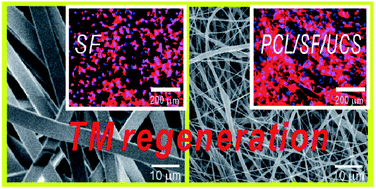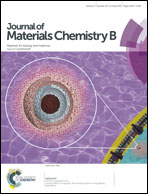A polycaprolactone/silk-fibroin nanofibrous composite combined with human umbilical cord serum for subacute tympanic membrane perforation; an in vitro and in vivo study
Abstract
Due to its good mechanical reinforcement and large number of basic amino acids, silk fibroin (SF) has been widely used in tissue regenerative applications as a bioactive dispersed phase of a biocomposite system. In this work, we fabricated an electrospun polycaprolactone (PCL)/SF composite and combined the composite scaffold with human umbilical cord serum (UCS) to facilitate cell growth. Various in vitro cellular activities (cell-viability, MTT assay, and fluorescence analysis) for the electrospun pure PCL, pure SF, PCL/SF, and PCL/SF/UCS scaffolds were compared. The PCL/SF/UCS based scaffolds showed highly improved bioactive properties compared with pure PCL and SF. The efficiency and feasibility for regenerating in vivo subacute tympanic membrane (TM) perforation in guinea pigs was also evaluated for the PCL/SF/UCS scaffold. The closure of the TM perforation using the scaffold was rapid; the auditory brainstem response (ABR) threshold at all frequencies of the composite demonstrated significant recovery, approaching normal levels.


 Please wait while we load your content...
Please wait while we load your content...